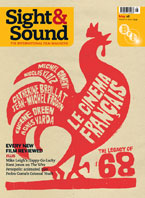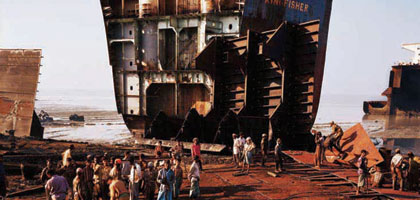Primary navigation

Canada 2006

Reviewed by Mark Sinker
Our synopses give away the plot in full, including surprise twists.
China and Bangladesh, the present. This documentary parallels the 2003 book of the same name, a retrospective of the work of photographer Edward Burtynsky, who records the effects of the extractive industries as they reshape the world around them. His gallery images - of oilfields, mining and related processes - are large and extremely detailed, and we follow the making of some of them, mostly in China, which we see in the throes of industrialisation on a world-historical scale. Invited to cover the construction of the world's largest dam, the Three Gorges, Burtynsky shows us how it is linked to the recycling of western waste and the rise of a vast shipping industry, with ancient port-cities like Shanghai exploding in population and modernity. He sets China's ambition to transform and enrich itself in the context of global warming and peak oil, pollution and social need.
By 1790, the Black Country, a once-wild landscape in the UK's northern midlands, had become a maze of forges, collieries and "tall chimneys belching metallic vapours and at night lit by flames." Its pale inhabitants, appalled observers saw, were ragged in black, with streaming red eyes and hair stained green with copper. Thus historian Arthur Bryant's vividly written snapshot of the first Industrial Revolution as it began to unleash the energy and miseries that made the British Empire and changed the world. Edward Burtynsky's photographs - a different kind of history-writing altogether - catch the detail and the scale of another industrialising revolution, history taking its next turn, apparently transforming the fortunes of another, older empire: China's, as its population of 1.3 (US) billion seeks to lurch from nine-tenths agrarian 30 years ago to seven-tenths urban (Beijing's current plan). We see the vast interiors of factories; giant tips of reclaimed machine trash, imported from far-off nations to be recycled; we see titanic earthworks such as the Three Gorges Dam, a 17-year project involving the relocation of up to two million people; we see the emergence of great cities in new garb - Shanghai as a metropolis of real-estate deals and skyscrapers.
In a sense this is a photo collection opened up and brought to life, with commentary, behind-the-scenes fly-on-the-wall on the negotiation and aftermath of some of the shoots, and some input, overheard or via interview or official statement, from the human subjects, who feature as often as not as minute specks dwarfed by the man-made mountains behind them. Indeed Burtynsky and director Jennifer Baichwal's main device is a kind of trompe l'oeil of scale, whether it's starting with a scene then zooming out until you realise that the busy space you first looked at is all but lost in depths of the picture as a whole; or panning back further, till you see the entire picture on a gallery wall being peered at by punters; or cutting from a deserted city of rubble, about to be inundated as the dam is filled, to a pulsing neon city of the future, only to realise it's an architect's model; or showing an enormous yard full of shipping containers from the air, so that momentarily you don't know if it's a circuit board, or shelving, or art, or what size it is. And then there's the striking opening scene, an eight-minute walking-pace wordless dolly across an endless factory floor - until you wonder if there isn't a clever loop in the film...
Since the purpose is to unveil the interconnectedness of tiny, medium-sized, large and global - their relationships and mutual effects - the sense that you're not actually getting all the information you need in order to know what to make of what you're seeing feels less disingenuous than part of a dramatising game, rendering the invisible visible. And Burtynsky absolutely has a Ballardian eye for the incongruous, some vast machine shape out of its place and time: the most striking section is perhaps the briefest, when he focuses on Chittagong shipbreaking beach in Bangladesh, where huge rusting tankers sit stranded on otherwise naked mudflats, scavenged and dismantled by local teenagers. We're told almost nothing about this set-up - except that it's very poorly paid and very dangerous - but Burtynsky perhaps judges the force of the image more effective than any lecture about economics or sociology. The oddest thing, after all, about omnipresent globalisation is that globalisation is shipping by and large - and yet shipping is indeed culturally invisible these days, even more so than the notion of China as the world's landfill, the detritus of our modernism the raw matter of their future, busily refashioned to be sold back to us before the oil vanishes (or else the climate).
Visually, the film is rich and subtle - Burtynsky finds an eerie beauty in the starkest, most poisoned, emptied vistas; what's deathly here is also potent and haunting. The words and music are less successful - the former somewhat diffident and unspecific, perhaps tactically, the latter rather off-the-peg, an Eno-esque soundtrack to an arch suspension of judgement. And the problem of the cliché of the Chinese as a teeming, purposeful yet inscrutable ocean of humanity is perhaps not quite pushed back against as much as it might be. The thrill of vicarious terror - at such landscapes and such mass social convulsions - is after all a classic Romantic trope, with its heyday in England's Industrial Revolution: the Sublime. Back then it was a very western worship of the nature-demons as they threatened and invigorated settled society; the emotional and mythological energies drawn on here aren't so different; the times really perhaps are.